The thousand faces of a legend
Marlon Brando in the mirror. by Elisabetta Randaccio (English translation by Rita Imperiali)
Dopo l'articolo la versione in italiano
While his colleagues and famous friends like James Dean and Marilyn Monroe passed away at a young age, leaving behind for their fans an image set in beauty and melancholy, Marlon Brando (1924-2004), passed away at 80, his body wretched by obesity and diabetes and an acute respiratory disease.
He certainly led a complex life, but 10 years after his death, what stands out is that his career was extraordinary.
He was not in more than 40 films, and yet his presence on the big screen, had an heavyweight influence in the acting field, as a pop icon, as the stereotype film star that stumbles and rises again, turning away from success sometimes at the price of hurting himself with poor professional choices.
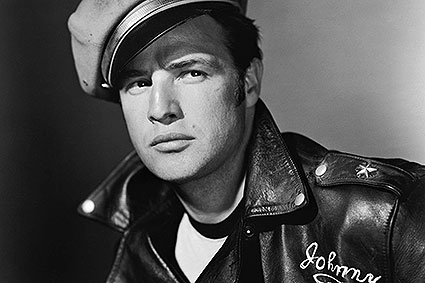 All that said, it’s rare to find in the history of cinema an actor like him that embodied the legend of absolute all-around talent, with an outstanding success, impacting with few movies entire generations of audiences.
All that said, it’s rare to find in the history of cinema an actor like him that embodied the legend of absolute all-around talent, with an outstanding success, impacting with few movies entire generations of audiences.
His first persona was the one of ‘rebel without a cause’ (the title of the movie by Nicholas Ray with James Dean, 1955) during second post-war in America. As the social crisis loomed, the generation gap was defined drastically, young people were at the forefront of aspirations and institutional changes, the same changes that were being crushed by the hypocrisy and the sexual ad political suppression of the United States of that time. Marlon Brando, with the support of directors like Zinnemann and Kazan, introduced a character, totally original, that will open the door to violent unrest, depression and regret that his fellow actors will imitate for more than a decade, staying away from stereotypes in their own way. In fact, for many years Paul Newman was plagued by those who branded him ‘the new Brando’.
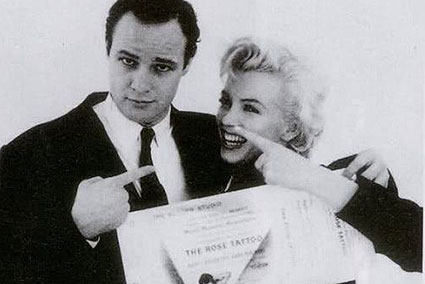 Marlon not only was able to embody the spirit of the times, but he suggested a new way to tackle cinematic rendition, that came alive from a body and a voice out of the ordinary. His beauty was youthful, non conventional: his body was part of his strength, he would act with a strong sexual tone without filters (case in point, the use of the T-shirt in ‘A Streetcar Named Desire’, 1951 by Elian Kazan, it did accentuate his muscles and even when sweaty and dirty, clearly shows the character of Stanley: aggressive and fragile at the same time).
Marlon not only was able to embody the spirit of the times, but he suggested a new way to tackle cinematic rendition, that came alive from a body and a voice out of the ordinary. His beauty was youthful, non conventional: his body was part of his strength, he would act with a strong sexual tone without filters (case in point, the use of the T-shirt in ‘A Streetcar Named Desire’, 1951 by Elian Kazan, it did accentuate his muscles and even when sweaty and dirty, clearly shows the character of Stanley: aggressive and fragile at the same time).
This manly physique was counteracted by an almost frail voice that at the same time was successful in using mumbling and muttering in a drawl. According to the ‘Method’ of the Actor’s Studio (brought to a cinematic cliché’ by Marlon Brando himself) this would be indicative of complex anxieties of infantile-adolescent origins
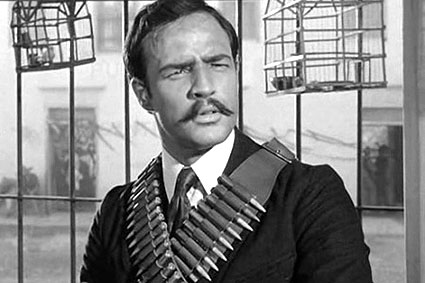 In Italy, this important feature of Brando’s acting was lost in the dubbing, the idea was to match the physique with the voice, and the choice was to go for a deep tone, but that was not adequate for the true originality of the actor in ‘On the Waterfront’. Therefore the first step in the analysis of Brando film career is to revisit his movies in the original language.
In Italy, this important feature of Brando’s acting was lost in the dubbing, the idea was to match the physique with the voice, and the choice was to go for a deep tone, but that was not adequate for the true originality of the actor in ‘On the Waterfront’. Therefore the first step in the analysis of Brando film career is to revisit his movies in the original language.
In the first part of his career the actor became a pop-icon as the ringleader of the motorcycle gang from ‘The Wild One’ by Laszlo Benedeck (1953), with leather jacket and visor hat. Brando is a rebel, but not a revolutionary, even though he plays Emiliano Zapata in the beautiful movie, again by Elia Kazan (‘Viva Zapata!’ 1952). Gigi Livio in his outstanding piece ‘The Cinematographic Actor’ (Published by Zona, 2007) describes Brando: ‘he stumbles as he speaks, slobbers, moves his eyes… in his usual way, like a wounded animal that hates everything and everybody, because everything and everybody can harm him, he sports a sullen look… that he carries throughout the whole movie, as if expressing his bitterness toward a world that does not understand him’. He pre-empties from any bias the historical character, changing him as underlined by Livio, from a revolutionary to a rebel, exactly as his character.
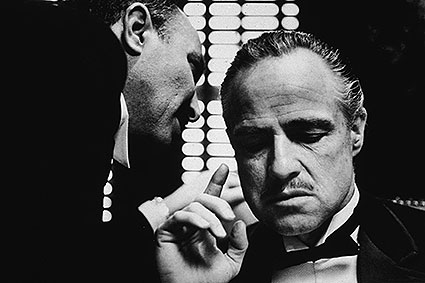 At any rate, Hollywood would always devour rebels whether real or made-up, and here comes the Oscar nomination for ‘On The Waterfront’ along with top money for any work attached to his name. But all this does not end well, since the actor, who finances his most extreme ventures, like an island in the Pacific, starts showing apprehension that translates in disastrous career choices. All that said, few are the bad movies, but Brando squanders the favor of the audience, choosing to play devious characters, less empathetic, stressing in a grotesque way his acting, refusing to budge to the political correct, sometime falling short of a funny parody.
At any rate, Hollywood would always devour rebels whether real or made-up, and here comes the Oscar nomination for ‘On The Waterfront’ along with top money for any work attached to his name. But all this does not end well, since the actor, who finances his most extreme ventures, like an island in the Pacific, starts showing apprehension that translates in disastrous career choices. All that said, few are the bad movies, but Brando squanders the favor of the audience, choosing to play devious characters, less empathetic, stressing in a grotesque way his acting, refusing to budge to the political correct, sometime falling short of a funny parody.
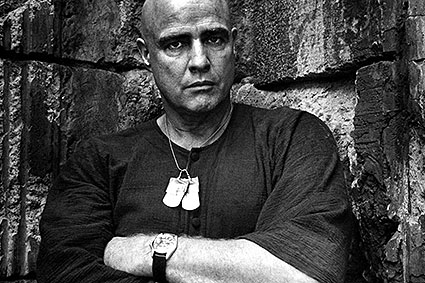 Therefore at 40, even though some movies confirm his talent (for example ‘Reflections in a Golden Eye’, 1967 by John Huston) the decadent Hollywood of the sixties defines him as a ‘has-been’. In 1971 a new iconic character awaits him: Don Vito Corleone in ‘The Godfather’ that starts a tale, with a Shakespearean tone, written by Francis Ford Coppola. In this case, Brando’s voice not at all booming, assisted by a technical device, becomes the winning card to capture the old boss, so affectionate with his grandson and yet merciless with his enemies. The worldwide incredible success of ‘The Godfather’ shows his monumental performance, and for that he will receive his second Oscar, that was accepted by a native American to emphasize Brando’s social commitment, always present, since the march for civil rights in 1963 where he was immortalized in a famous picture.
Therefore at 40, even though some movies confirm his talent (for example ‘Reflections in a Golden Eye’, 1967 by John Huston) the decadent Hollywood of the sixties defines him as a ‘has-been’. In 1971 a new iconic character awaits him: Don Vito Corleone in ‘The Godfather’ that starts a tale, with a Shakespearean tone, written by Francis Ford Coppola. In this case, Brando’s voice not at all booming, assisted by a technical device, becomes the winning card to capture the old boss, so affectionate with his grandson and yet merciless with his enemies. The worldwide incredible success of ‘The Godfather’ shows his monumental performance, and for that he will receive his second Oscar, that was accepted by a native American to emphasize Brando’s social commitment, always present, since the march for civil rights in 1963 where he was immortalized in a famous picture.
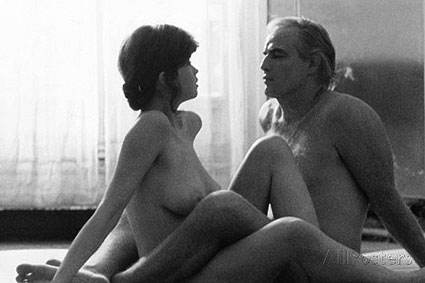 This last tribute opens the door to his participation in another important film, at least in Italy, thanks to a frenzied dammed attach by the censors: ‘Last Tango in Paris’, 1972 by Bernardo Bertolucci. The character of Paul was not written for him (it seems that it was originally created for Jean-Louis Trintignant), but Brando during the shooting makes it his own: the story seems almost an autobiographical confession, a synthesis of the road from young rebel to beaten cynic, and at the end fragile and resigned. Following this vein is the part of Kurtz in ‘Apocalypse Now’ (Francis Ford Coppola, 1979), this was a movie cursed by incredible happenings during production. Coppola saves for Brando a final section of the movie where the great actor plays the dark soul of the man, floating between darkness and pale light, disturbing image of how horror can be so lucid.
This last tribute opens the door to his participation in another important film, at least in Italy, thanks to a frenzied dammed attach by the censors: ‘Last Tango in Paris’, 1972 by Bernardo Bertolucci. The character of Paul was not written for him (it seems that it was originally created for Jean-Louis Trintignant), but Brando during the shooting makes it his own: the story seems almost an autobiographical confession, a synthesis of the road from young rebel to beaten cynic, and at the end fragile and resigned. Following this vein is the part of Kurtz in ‘Apocalypse Now’ (Francis Ford Coppola, 1979), this was a movie cursed by incredible happenings during production. Coppola saves for Brando a final section of the movie where the great actor plays the dark soul of the man, floating between darkness and pale light, disturbing image of how horror can be so lucid.
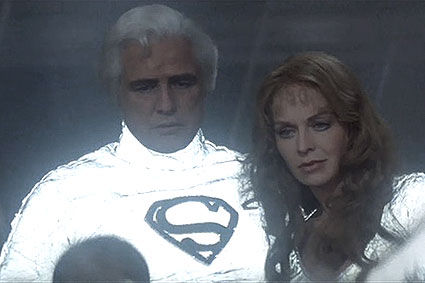 The last two decades the career of Brando were sprinkled with cameos appearances in some good movies and some bad, but if we look at ‘Don Juan De Marco’ by Jeremy Leven (1995), we see how happy the actor is to play in fine piece of work. The many lead shots, in fact show the joy, a certain serene performance, and the pleasure to act with a younger colleague, Jonny Depp, one of the new rebels, that could learn a thing or two from him : how wonderful is to dream and build success, and how bitter is to pretend in life and on screen.
The last two decades the career of Brando were sprinkled with cameos appearances in some good movies and some bad, but if we look at ‘Don Juan De Marco’ by Jeremy Leven (1995), we see how happy the actor is to play in fine piece of work. The many lead shots, in fact show the joy, a certain serene performance, and the pleasure to act with a younger colleague, Jonny Depp, one of the new rebels, that could learn a thing or two from him : how wonderful is to dream and build success, and how bitter is to pretend in life and on screen.
I mille volti di un mito
Marlon Brando allo specchio. di Elisabetta Randaccio
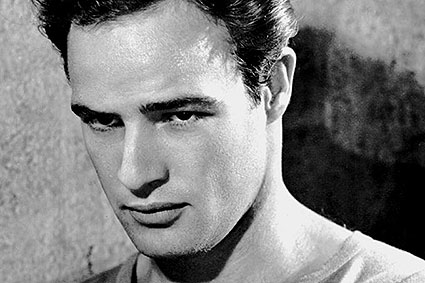 Mentre i suoi colleghi e amici altrettanto famosi, come James Dean o Marilyn Monroe, sono morti in giovane età, lasciando ai fan e ai posteri una immagine fermata precocemente nella bellezza e nella melanconia, Marlon Brando (1924-2004) è deceduto a 80 anni, provato nel fisico dall'obesità, dal diabete e da un'acuta malattia respiratoria.
Mentre i suoi colleghi e amici altrettanto famosi, come James Dean o Marilyn Monroe, sono morti in giovane età, lasciando ai fan e ai posteri una immagine fermata precocemente nella bellezza e nella melanconia, Marlon Brando (1924-2004) è deceduto a 80 anni, provato nel fisico dall'obesità, dal diabete e da un'acuta malattia respiratoria.
La sua vita personale è stata certamente complessa, ma quello che qui interessa, nel ricordarlo a dieci anni dalla sua scomparsa, è una carriera straordinaria.
 Pur non essendo andato oltre una quarantina di film, la sua presenza sul grande schermo ha implicato una pesante influenza sia nel campo della recitazione, sia come icona pop, sia all'interno dello stereotipo della stella che cade e si rialza, sia in quello del rifiuto del successo con conseguente autolesionismo nelle scelte professionali. Però, si potrebbe trovare raramente, nella storia del cinema, un attore che, in varie decadi, abbia incarnato al pari di lui il mito del talento assoluto e versatile, con un successo straordinario, segnando con pochi film intere generazioni di spettatori.
Pur non essendo andato oltre una quarantina di film, la sua presenza sul grande schermo ha implicato una pesante influenza sia nel campo della recitazione, sia come icona pop, sia all'interno dello stereotipo della stella che cade e si rialza, sia in quello del rifiuto del successo con conseguente autolesionismo nelle scelte professionali. Però, si potrebbe trovare raramente, nella storia del cinema, un attore che, in varie decadi, abbia incarnato al pari di lui il mito del talento assoluto e versatile, con un successo straordinario, segnando con pochi film intere generazioni di spettatori.
La sua prima maschera è quella del “ribelle senza causa” (titolo del film di Nicholas Ray con James Dean, 1955) nell'America del secondo dopoguerra, in cui la crisi sociale incombe, si definisce drammaticamente il gap generazionale e i giovani sono portatori di desideri e novità istituzionali, che l'ipocrisia, la repressione allargata dal sesso alla politica comune negli Stati Uniti dell'epoca, provarono a cassare.
 Marlon Brando, con il supporto di registi come Zinnemann e Kazan, si imporrà in un personaggio, allora assolutamente originale, che spianerà la strada alle inquietudini violente, alle depressioni e ai rancori che i suoi colleghi interpreteranno per un decennio intero, declinando gli stereotipi, per quanto in maniera personale. Così, per esempio, per alcuni anni, Paul Newman fu tormentato da chi lo classificava come “nuovo Brando”.
Marlon Brando, con il supporto di registi come Zinnemann e Kazan, si imporrà in un personaggio, allora assolutamente originale, che spianerà la strada alle inquietudini violente, alle depressioni e ai rancori che i suoi colleghi interpreteranno per un decennio intero, declinando gli stereotipi, per quanto in maniera personale. Così, per esempio, per alcuni anni, Paul Newman fu tormentato da chi lo classificava come “nuovo Brando”.
Marlon, però, non seppe incarnare semplicemente lo spirito dei tempi, ma propose un nuovo modo di affrontare l'interpretazione cinematografica, che prendeva vita da un fisico e una voce fuori dalla norma. La sua infatti, era una bellezza giovanile, non canonica; il corpo era parte della sua forza recitativa, con forte accentuazione sensuale senza filtri (si veda, in questo senso, l'uso della t-shirt in “Un tram che si chiama Desiderio”, 1951, di Elia Kazan, che accentua la muscolatura e, quando ormai è sporca e sudata, diviene una chiarificazione del carattere di Stanley: aggressivo e fragile, allo stesso tempo).
 Questo corpo urlato al maschile era apparentemente contraddetto da una voce quasi fragile, la quale, però, diventava vincente nell'utilizzazione del mumbling, il borbottio strascicato, che, nell'ottica del “metodo” dell'Actor's Studio (portato persino alla banalizzazione cinematografica proprio a iniziare da Marlon Brando), evocava complesse angosce di derivazione infantile-adolescenziale. Questa caratteristica così importante della recitazione di Brando, in Italia si perdeva nel doppiaggio, tendente a omologare fisico e voce con la scelta di toni profondi, dunque, inadeguati alla vera originalità dell'attore di “Fronte del porto”. Per cui il primo passaggio da cui partire in una ricomposizione del Brando cinematografico è quello di rivedere i suoi film, finalmente, in lingua originale.
Questo corpo urlato al maschile era apparentemente contraddetto da una voce quasi fragile, la quale, però, diventava vincente nell'utilizzazione del mumbling, il borbottio strascicato, che, nell'ottica del “metodo” dell'Actor's Studio (portato persino alla banalizzazione cinematografica proprio a iniziare da Marlon Brando), evocava complesse angosce di derivazione infantile-adolescenziale. Questa caratteristica così importante della recitazione di Brando, in Italia si perdeva nel doppiaggio, tendente a omologare fisico e voce con la scelta di toni profondi, dunque, inadeguati alla vera originalità dell'attore di “Fronte del porto”. Per cui il primo passaggio da cui partire in una ricomposizione del Brando cinematografico è quello di rivedere i suoi film, finalmente, in lingua originale.
 Nella prima parte della sua carriera l'attore diventò un'icona pop, anche per merito del capobanda dei motociclisti vagabondi de “Il selvaggio” di Laszlo Benedeck (1953), con giubbotto di pelle e cappello a visiera. Così, Brando è “ribelle”, ma certo non rivoluzionario, nonostante incarni in un film molto bello, ancora di Elia Kazan (“Viva Zapata”, 1952), Emiliano Zapata. Come scrive Gigi Livio in un notevole saggio su “L'attore cinematografico” (Zona editore, 2007), Brando, in questo lungometraggio, “incespica nel parlare, biascica, muove gli occhi... nel suo modo solito, da animale ferito che odia tutti e tutto perché tutto e tutti lo possono colpire, inalbera un broncio... che si porterà dietro per tutto il film, con cui esprime il risentimento per un mondo che non lo capisce”, svuotando di ideologia il personaggio storico, facendolo diventare, come sottolinea Livio, da rivoluzionario a ribelle, esattamente come il suo personaggio.
Nella prima parte della sua carriera l'attore diventò un'icona pop, anche per merito del capobanda dei motociclisti vagabondi de “Il selvaggio” di Laszlo Benedeck (1953), con giubbotto di pelle e cappello a visiera. Così, Brando è “ribelle”, ma certo non rivoluzionario, nonostante incarni in un film molto bello, ancora di Elia Kazan (“Viva Zapata”, 1952), Emiliano Zapata. Come scrive Gigi Livio in un notevole saggio su “L'attore cinematografico” (Zona editore, 2007), Brando, in questo lungometraggio, “incespica nel parlare, biascica, muove gli occhi... nel suo modo solito, da animale ferito che odia tutti e tutto perché tutto e tutti lo possono colpire, inalbera un broncio... che si porterà dietro per tutto il film, con cui esprime il risentimento per un mondo che non lo capisce”, svuotando di ideologia il personaggio storico, facendolo diventare, come sottolinea Livio, da rivoluzionario a ribelle, esattamente come il suo personaggio.
 Hollywood, poi, i ribelli, veri o presunti, se li mangiava in un boccone ed ecco arrivare per Brando la consacrazione con l'Oscar per “Fronte del porto” e le montagne di soldi per qualsiasi progetto prevedesse in cartellone il suo nome. Ma questa strada dorata non va a buon fine, perché l'attore, il quale i soldi li investe nei suoi desideri più estremi, compreso l'acquisto di un'isola nel Pacifico, inizia a mostrare un disagio, che si concreta in disastrose scelte di carriera. In realtà, i brutti film, in fondo, sono pochi, ma Brando dilapida il favore del pubblico, scegliendo personaggi ambigui, poco empatici, accentuando nel livello del grottesco la sua recitazione, rifiutando il politicamente corretto, a volte, scivolando nella parodia divertita.
Hollywood, poi, i ribelli, veri o presunti, se li mangiava in un boccone ed ecco arrivare per Brando la consacrazione con l'Oscar per “Fronte del porto” e le montagne di soldi per qualsiasi progetto prevedesse in cartellone il suo nome. Ma questa strada dorata non va a buon fine, perché l'attore, il quale i soldi li investe nei suoi desideri più estremi, compreso l'acquisto di un'isola nel Pacifico, inizia a mostrare un disagio, che si concreta in disastrose scelte di carriera. In realtà, i brutti film, in fondo, sono pochi, ma Brando dilapida il favore del pubblico, scegliendo personaggi ambigui, poco empatici, accentuando nel livello del grottesco la sua recitazione, rifiutando il politicamente corretto, a volte, scivolando nella parodia divertita.
Così, a quarant'anni, nonostante alcuni film ribadiscano il suo talento (si pensi, per esempio a “Riflessi in un occhio d'oro”, 1967, di John Huston) la Hollywood decaduta degli anni sessanta può definirlo “finito”.
 Ma nel 1971, un altro personaggio iconico lo aspetta: Don Vito Corleone nel primo “Padrino”, che dà il via alla saga, di tono shakespeariano, scritta da Francis Ford Coppola. In questo caso, la voce tutt'altro che stentorea di Brando, accentuata da artifici recitativi e tecnici, si rivela la carta vincente per delineare il vecchio boss, così affettuoso con il nipotino e così spietato con i nemici. Il successo incredibile, planetario del “Padrino” comprende la sua fondamentale interpretazione, per cui avrà il secondo Oscar, fatto ritirare da una “nativa” pellerossa, a sottolineare l'impegno civile di Brando, sempre presente, sin dai tempi della marcia per i diritti civili del 1963, in cui venne immortalato in una celebre fotografia.
Ma nel 1971, un altro personaggio iconico lo aspetta: Don Vito Corleone nel primo “Padrino”, che dà il via alla saga, di tono shakespeariano, scritta da Francis Ford Coppola. In questo caso, la voce tutt'altro che stentorea di Brando, accentuata da artifici recitativi e tecnici, si rivela la carta vincente per delineare il vecchio boss, così affettuoso con il nipotino e così spietato con i nemici. Il successo incredibile, planetario del “Padrino” comprende la sua fondamentale interpretazione, per cui avrà il secondo Oscar, fatto ritirare da una “nativa” pellerossa, a sottolineare l'impegno civile di Brando, sempre presente, sin dai tempi della marcia per i diritti civili del 1963, in cui venne immortalato in una celebre fotografia.
 Questa ennesima consacrazione spiana la partecipazione ad un altro film importante e, almeno in Italia, grazie a un delirante attacco censorio, maledetto: “Ultimo tango a Parigi”, 1972, di Bernardo Bertolucci. Il personaggio di Paul non era stato scritto per lui (pare lo dovesse interpretare Jean- Louis Trintignant), eppure, nel corso delle riprese, Brando si impossessa del protagonista; quella storia pare una sorta di confessione autobiografica, una sintesi del percorso del giovane ribelle a sconfitto cinico e, poi, alla fine, fragile e perdente. Sempre in quest'ottica, anche la parte di Kurtz in “Apocalypse now” (Francis Ford Coppola - 1979), questo veramente un film maledetto per le incredibili vicissitudini della produzione.
Questa ennesima consacrazione spiana la partecipazione ad un altro film importante e, almeno in Italia, grazie a un delirante attacco censorio, maledetto: “Ultimo tango a Parigi”, 1972, di Bernardo Bertolucci. Il personaggio di Paul non era stato scritto per lui (pare lo dovesse interpretare Jean- Louis Trintignant), eppure, nel corso delle riprese, Brando si impossessa del protagonista; quella storia pare una sorta di confessione autobiografica, una sintesi del percorso del giovane ribelle a sconfitto cinico e, poi, alla fine, fragile e perdente. Sempre in quest'ottica, anche la parte di Kurtz in “Apocalypse now” (Francis Ford Coppola - 1979), questo veramente un film maledetto per le incredibili vicissitudini della produzione.
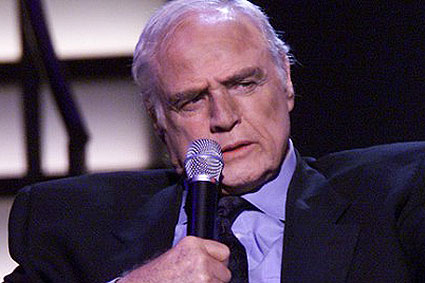 Coppola ritaglia per Brando una sezione conclusiva del film dove il grande attore recita la buia anima dell'uomo, ondeggiando su oscurità e falci di luce, simbolo inquietante di quanto può essere lucido l'orrore.
Coppola ritaglia per Brando una sezione conclusiva del film dove il grande attore recita la buia anima dell'uomo, ondeggiando su oscurità e falci di luce, simbolo inquietante di quanto può essere lucido l'orrore.
Gli ultimi due decenni della carriera di Brando sono costellati soprattutto da “camei” in film buoni e anche molto brutti, ma, se si recupera “Don Juan De Marco” di Jeremy Leven (1995) si vede come l'attore sia felice di recitare ancora in un'opera di buon livello. I numerosi primi piani, infatti, ne mettono in evidenza la gioia, una sorta di serenità interpretativa e il piacere di recitare con un collega giovane, Johnny Depp, uno di quei nuovi ribelli, a cui lui potrebbe insegnare tanto, quanto è bello sognare e costruire il successo, quante è amara la finzione nella vita e sullo schermo.
9 luglio 2014

